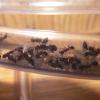Anyone know how to tell the difference between the queens and workers of P. pennsylvanicus? There's a large population of them in the woods by my apartment but I really cannot tell if I'm seeing the queens or not
The queens are usually slightly longer than the workers and have a slightly larger thorax. They are difficult to spot in a colony, I will say. One thing to note is that they can mate on the ground, so be looking out for that. That being said, you will be able to tell the difference pretty quickly if you look at them closely, at least in my experience.
Edited by Ants_Dakota, March 28 2025 - 4:55 AM.


















